Famiglia : Fagaceae

Text © Prof. Paolo Grossoni

English translation by Mario Beltramini
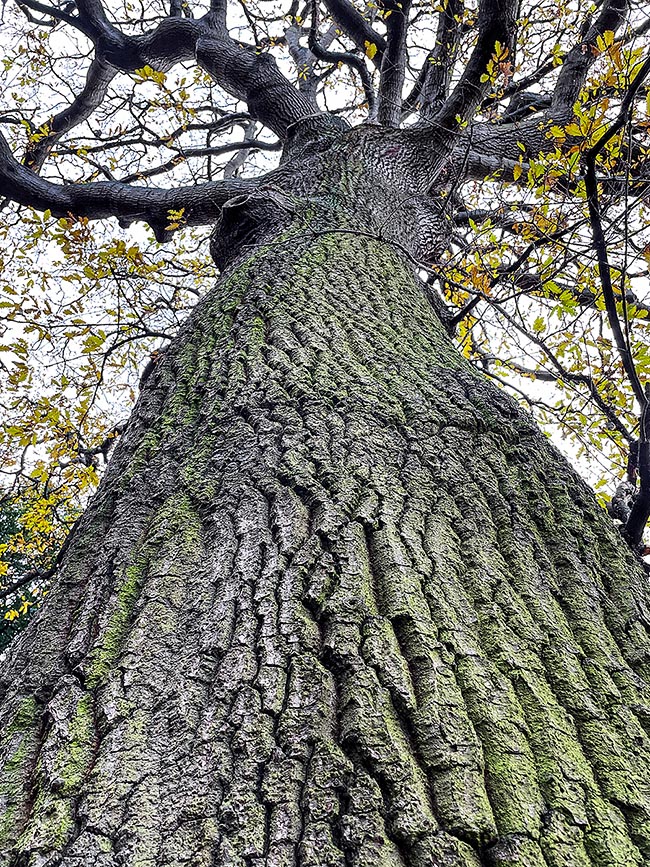
Straight and slender trunk of an adult Austrian oak. The bark rhytidome is deeply grooved in crests separated by vertical and horizontal furrows of rather clear colour and more or less flattened outside © Terrence Pickles
Inserted as “LC, Least Concern“, that is not endangered due to its vast range in the IUCN Red List, Quercus cerris L., is known as “cerro” in Italian, “chêne chevelu” in French, and Austrian oak in English, “Zerreiche” and “Zirneiche” in German and “Roble cabelludo” or Roble de Turquia” in Spanish.
Romans did call it “cerrus” thus distinguishing it from “quercus”, the other deciduous oaks.
In the distribution of the genus Quercus done by Denk and collaborators in 2017 (Tree Physiology. Vol. 7. p. 13-38. Springer) the Austrian oak is inserted into the Fagaceae, section Cerris of the homonymous subgenus and distinguishes from the sectn. Quercus of the other subgenus because the plants do not emit volatile organic compounds (VOC), the acorns have glabrous endocarp and, especially, ripen in two years.
The section Cerris is composed of 11 (13) species of the Old World, among these, 8 are present in the Mediterranean Eurasia, in North Africa and from the Iberian peninsula to Iran.
Among these ones, Quercus cerris, Quercus ithaburensis Decne., Quercus trojana Webb and Quercus suber L. live also in Europe. For two other taxa, Quercus crenata Lam. and Quercus gussonei (Borzì) Brullo, the systematic collocation is still the subject of research and discussion.
The Austrian oak does not have the same longevity as the other European deciduous oaks, as it reaches a maximum of 2-3 centuries of life.
It is a tree that may reach the height of 30-35 (40) metres with diameters up to 150 cm.
It has a slender and straight trunk that supports a rather dense oval-shaped crown but, in the coppices, has often a polycormic or shrubby habit.
During the first 10-15 years of life the rhytidome is dark gray and smooth; later on it cracks deeply in long and narrow longitudinal plaques separated by thin grooves of pink-intense orange to violet colour.
The small branch of the year is thin, angular, grey to olive, with white lenticels and with a brown reddish pubescence whilst the lateral small branches are more or less cylindrical.
The buds are inserted spirally; the most apical ones seem almost agglomerated at the apex because the internodes get shorter.
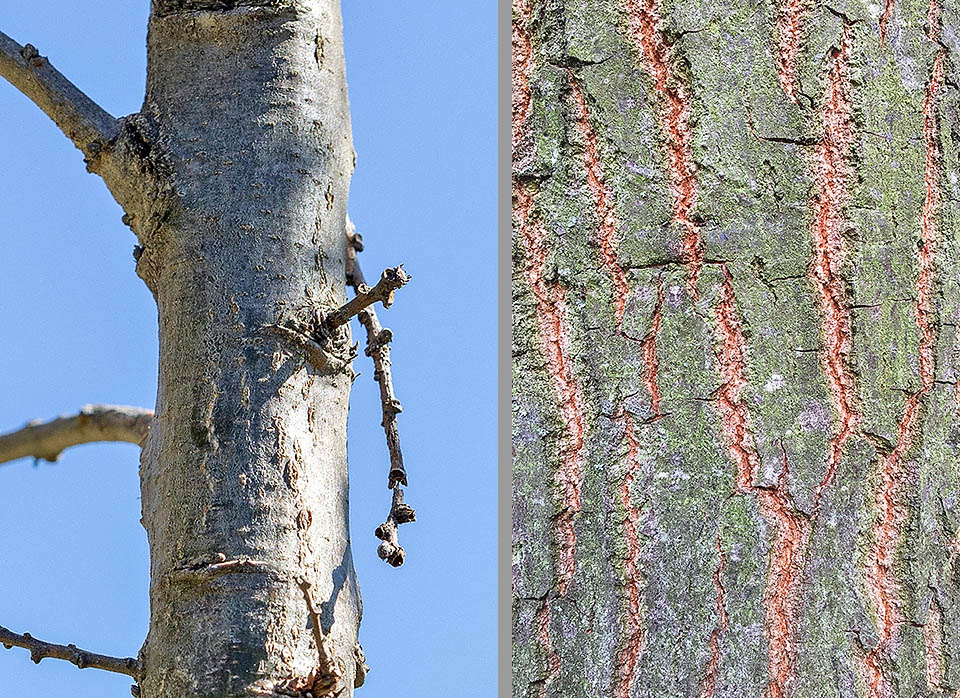
The trunk of a young Austrian oak with not yet fissured rhytidome compared to that of an adult one. During the first 10-15 years of life the rhytidome is dark grey and particularly smooth. This trait is particularly useful in the mixed woods of Austrian oak and downy oak as it allows to distinguish quickly the Austrian oak from the downy oak (Quercus rubescens) because the latter since the fifth-seventh year of age begins to fissure the rhytidome of its stem © Giuseppe Mazza (left) and © Terrence Pickles
They are relatively small, have an ovoid shape, are pluriperulate, pubescent and equipped with lesiniform stipulae, thin and twisted, even up to 20-25 mm long and persistent throughout the growing season.
The leaves are deciduous, simple and penninerved, alternate and spirally arranged, quite variable in shape and size passing from oblanceolate to ovate or, pore frequently, to obovate. (5) 6-11 cm long and (2) 4 to 6 cm broad and with a 5-15 mm petiole, have the lamina, dark green above and lighter below, more or less deeply incised-lobed with 4-7 (9) pairs of unequal lateral lobes often triangular and also mucronate at the apex.
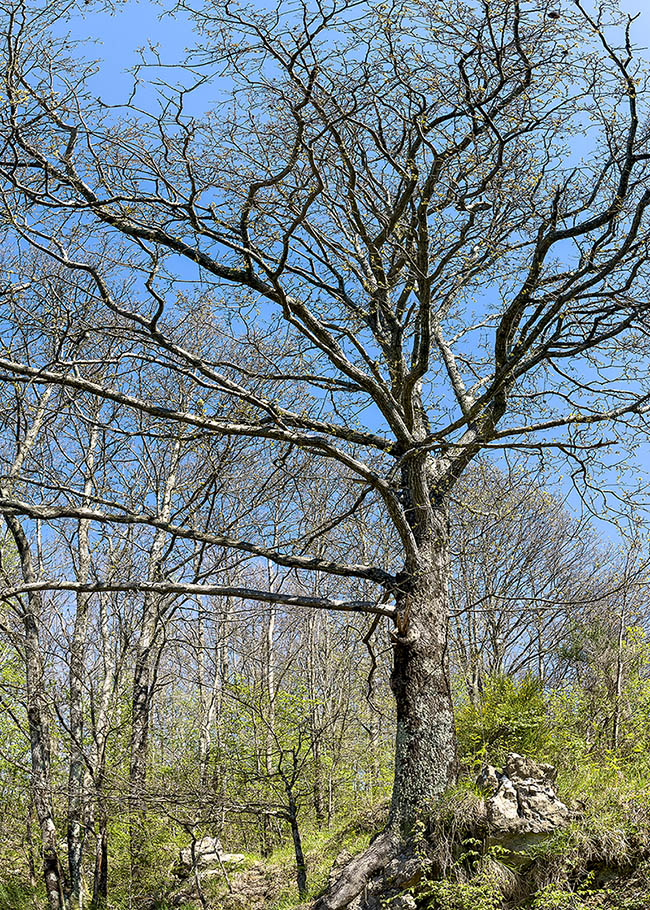
Grove of Austrian oaks in spring. With the verdant awakening of nature the first buds open timidly © Giuseppe Mazza
The base of the leaf may be truncated, rounded or, also, subcordate; are not uncommon leaves having no lobes but toothed along the edge.
The Austrian oaks with only toothed leaves are at times rightly inserted in the variety austriaca whilst for those with more or less laciniate leaves has been invented the var. haliphleos.
The leaves, quickly coriaceous, are above rough and coarse to the touch due to the presence of short stellate hairs, and consequently little flexible.
In autumn the leaves turn yellow or to a copper red; the abscission occurs late but, like in Quercus pubescens Wild., in the young plants and in the juvenile shaped branches the leaves remain, marcescent, on the plant till spring.
On the seedlings the leaves keep green all winter.
As hardness, the wood of the Austrian oak can be comparable to that of the other European deciduous oaks, but differs from them due to the yellowish colour of the sapwood and pinkish brown with violet shades of the heartwood and for its quality.
The porosity, annular, is pronounced because the woody vessels have thick walls; the parenchymatous rays are straight and thicker compared with those of the European deciduous oaks.
The root system is very robust and well developed in the secondary roots as well as in the taproot, that remains active during the entire life of the tree; this disposition favours the compactness of the soil thus favouring the tree’s resistance to the winds.
The flowering occurs in April-May; it is a monoecious species with flowers and inflorescences similar in the appearance to those of the other oak species. The male flowers have 4 stamens and are sparsely arranged on 5-8 cm long ears, pendulous, cylindrical, pauciflorous and inserted inserted mainly in the basal part of the twig of the year; the female ones, with 4 greenish stigmas, are single or united in short ears of 2-4 flowers at the axil of the buds of the distal part of the same twig.
The pollination is anemophilous and the leaves, in order not to hinder the wind in the pollen transportation, grow with a small delay compared to the flowers.
Like in the other species of the sectn. Cerris, the acorn ripens on the second year and, when the development is completed: this postponement of maturation is a strategy adopted by the species for overcoming the summer drought that, in the regions where the Austrian oak lives, has a beginning close to the flowering itself.
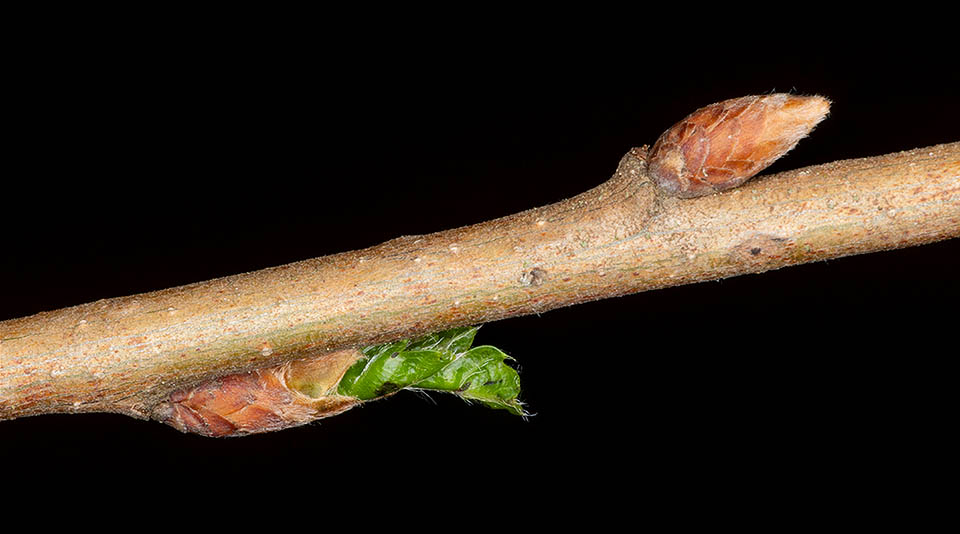
Two Quercus cerris vegetative lateral buds. THat on the lower part has already begun to sprout © Giuseppe Mazza
The egg cell postpones the meiosis to the beginning of the spring of the second year; the fertilization follows immediately and in the autumn season the acorn reaches the ripeness.
The ripe acorn, quite massive, (20) 30-40 (50) mm long and 12-18 (22) mm broad, is of reddish brown colour with numerous longitudinal striations and is mucronate.
The dome covers a third to a half of the fruit and is coated with subulate scales, up to 10 mm long, brown-dark, free and never approached that, as a whole, recall a hairy head (hence ‘chevelu’ in the common French name).
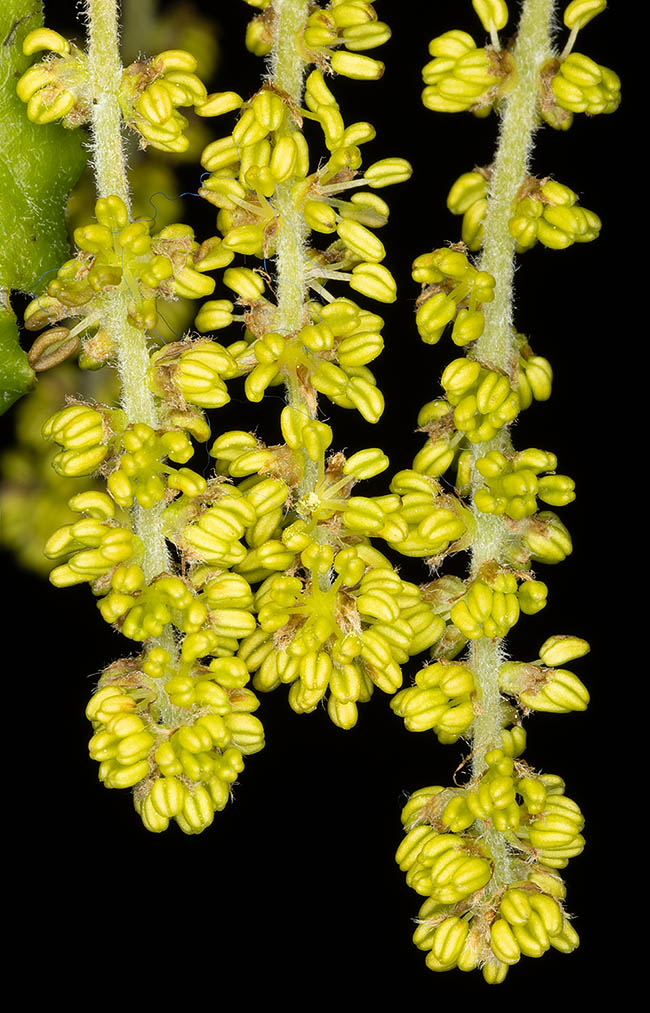
The male flowers have 4 stamens and are sparsely arranged on 5-8 cm ears, pending and cylindrical. Almost all their anthers are everted and the yellowish colour evidences that the pollen anemochorous dispersion is starting © Giuseppe Mazza
The acorn falls in the same autumn; it is not dormant and the germination, immediately after the fall, is hypogeous because the two cotyledons remain inside the integuments.
The young seedling has leaflets similar to those of the adult plant but covered by a thick whitish pubescence.
The distribution range of the Austrian oak extends from Sicily and the Italian peninsula up to the Black Sea and, through the central and eastern Alps, reaches the Balkan Danube states.
The Austrian oak is then present all over Turkey, and with the exception of the arid territories of central and eastern Anatolia, and along the mountain range of the Anti-Lebanon.
The Austrian oak has been introduced, even naturalizing, in other European regions, particularly in France (where however is spontaneous in the Maritime Alps), Great Britain and Ukraine.
It is also cultivated in other non-European states, especially in North America, Argentina and New Zealand.
The thermal optimum for this species corresponds to a climate still of Mediterranean type, but relatively more humid, cooler and with a very short lasting summer drought, characteristic to high hill or mountain areas.
This distribution of the Austrian oak mainly in the three large peninsulas of central-eastern Mediterranean (Italian, Balkan and Anatolian) has led to the affirmation of three main genetic groups: western (in the Italian peninsula and in the most continental part of the Balkan one), central (central and eastern regions of the Balkan peninsula) and eastern, related to the Austrian oaks of the Asian sector.
Even though it is heliophilous, with regards to the light, the Austrian oak is less demanding than the downy oak and, when young, it can overcome the competition of other species thanks to its growth speed.
For what the type of soil is concerned, it is ubiquitous as it does also tolerate not excessive clayey but never too arid soils. However, its optima are those of volcanic origin and the deep ones, fresh and subacid. It can be considered as a mesophilous oak concerning not only the water but also the temperatures. Quercus cerris goes to higher altitudes that, in the warmest and better exposed zones, reach 1.200-1.600 m a.s.l. in continental Europe and 1.800-1.900 m a.s.l. on the southernmost reliefs of the Anti-Lebanon chain.
Like in Quercus pubescens, also in Austrian oak the winter dormancy of the buds is fairly prolonged and the plant thus avoids risks of late frosts but, being, compared to the downy oak, more demanding about the humidity of the soil, when it grows in zones where the summer drought is precocious, the Austrian oak may undergo the drying up of the still immature shoots.
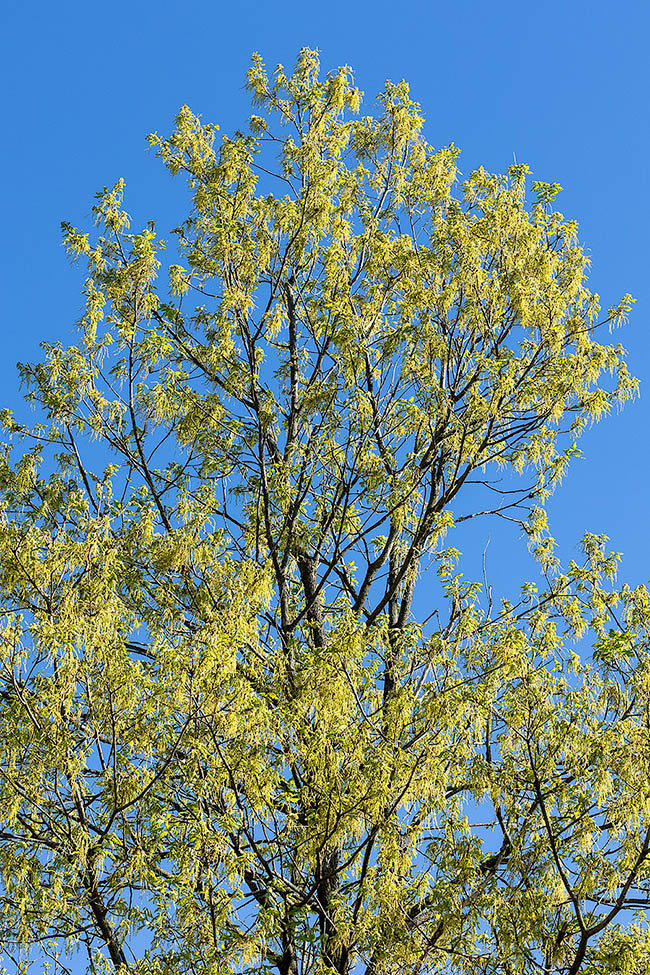
Fully flowering Austrian oak. The heavy male flowering gives temporarily the tree a new colouring © Giuseppe Mazza
The Austrian oak, not frequent in the Alpine region and in good part of Sicily, is contrarily an important forest species in several woods, high forests or coppices, mixed or pure, of the three large peninsulas of central-eastern Mediterranean.
The pure woods are very often the result of cultivation choices carried out over the centuries by man that have transformed mixed deciduous forests more or less rich in Austrian oaks into practically monospecific forests.
Very frequent and important are the deciduous woods of Austrian oak because they are highly productive.
The mixed woods where the Austrian oak is the dominant species or one of the co-dominant ones; cover in the above mentioned peninsulas even vast areas, most of the time including other deciduous oaks, mainly Quercus Quercus frainetto Ten., Quercus pubescens in Europe and Quercus libani Oliv. and Quercus ithaburensis in western Asia.
Compatible with their ecological requirements, we find there other oaks, like Quercus petraea (Matt.) Liebl., Quercus robur L., Quercus infectoria Oliv. and Quercus trojana, as well as arboreal species of other genera such as maples (Acercampestre L., Acer monspessulanum L., Acer opalus Mill., Acer tataricum L., Acer hircanum Fisch. & C.A.Mey.), Carpinus betulus L. and Carpinus orientalis Mill., Castanea sativa Mill., Celtis australis L., Corylus colurna L., Fagus sylvatica L., and Fraxinus ornus L., Ostrya carpinifolia Scop., Sorbus aria (L.) Crantz, , Tilia platyphyllos Scop. and Tilia tomentosa Moench, Ulmus minor Mill., etc.
Thera are also conifers with various species especially of the genera Abies, Pinus and Juniperus.
The woods of Austrian oak have a complex but fundamental rôle in the natural conservation dynamics of the forest topsoils favouring, thanks to the interactions with many vegetal species and with numerous fungal and animal communities living there, the quality and the richness of biodiversity and in the meantime preventing the soils erosion.
The wood, heavy and hard, is difficult to season because, while drying up, loses a lot of water and the wood materials obtained decrease in size (‘reduction’) but often split by warping or twisting.
Moreover, it is short lasting because the absence of tannins renders it easily attackable by rotting agents.
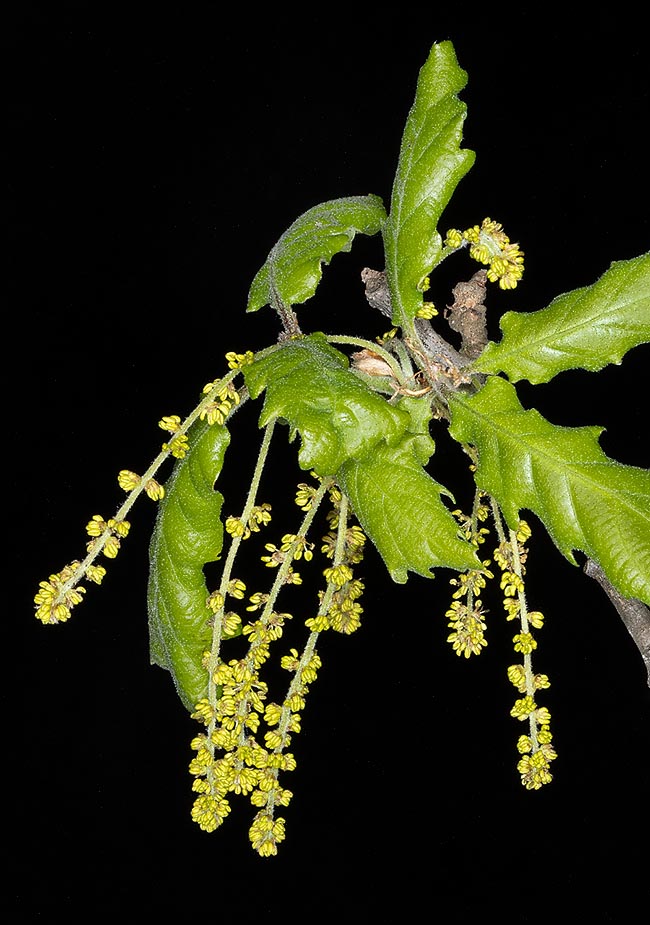
Flowering male ears of Quercus cerris with young leaves. The new shoot has not yet elongated and the margin of the leaflets does not appear yet completely stretched out to favour the wind carriage of the pollen © Giuseppe Mazza
It was occasionally used to make barrel staves and wheel spokes whilst a use still relatively common is the production of railway sleepers even if the wooden ones now constitute a small fraction of the proceeds of the final destination of the trunks.
Its most important employment is that of firewood and of coal production.
However, the Austrian oak has been diffused out from its range as a prominent tree in parks and gardens, alone or in small groups, thanks to the grandeurs of the adult plant, to the density of its crown and to the autumn colour change to the red or yellow of the leaves.
For this purpose have been selected some varieties with ornamental value for the leaves, variegated or heterochromatic when young, or with a particular shape.
‘Variegata’, ‘Argenteovariegata’, ‘Longifolia Nana’, ‘Laciniata’, ‘Curly Head’ and ‘Wodan’ stand among the most employed.
In urban environment, especially in industrial areas, it’s utilized to form road trees or windbreak barriers as it is relatively resistant to the air pollutants and because the pubescence of the twigs, of the leaves and of the stipulae increases the filtering action and of the sequestration of the atmospheric particulates (including particulates like the PM 10 and 2,5).
Its heliophilia, the possibility of living in numerous types of soil and the speed of growth render the Austrian oak an excellent pioneer species to be employed also for the reforestation of degraded areas.
Nevertheless, due its fast growth, the Austrian oak is one of the oaks where the roots are more affected by the cultivation treatments.
As a matter of fact, it is not easy to manage, because the taproot, that has a very fast growth since the first year, tends to grow deformed if the young plant is kept in pot, or is eliminated during the transplantations if it has been grown in soil.
The medicinal preparations obtained from various parts of the plant of the Austrian oak are numerous.
In particular the bark of the young branches, the leaves and the acorns are rich in phenols, like the gallic acid, polyphenols, like the tannins, and flavonoids, like the quercetine and, depending on the cases, their extracts have analgesic, anti-inflammatory, febrifugal, haemostatic, decongestant or invigorating properties.
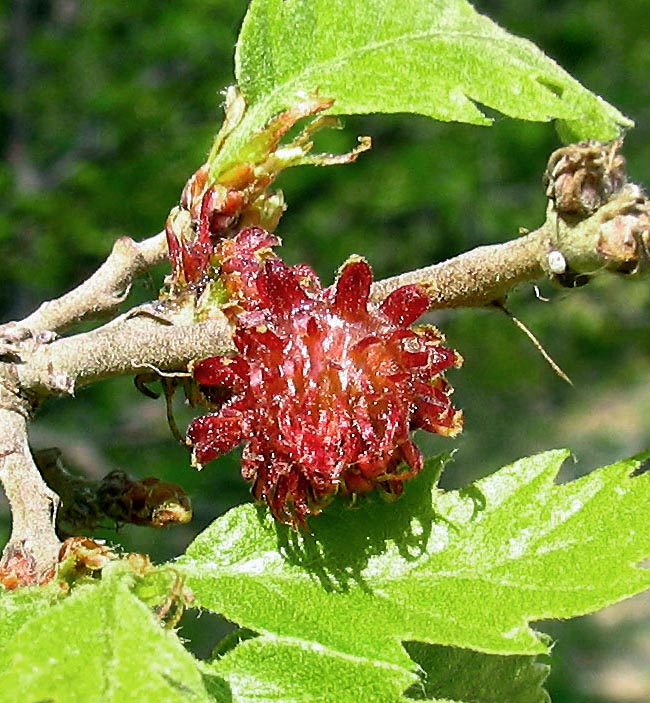
Female flower. Like in all oaks it is inserted on a short spike that bears here only one flower. The bract will later on become the dome of acorn. To note the twig hairiness, little visible but perceptible to the touch © Graziano Propetto
Despite the bitter taste, for bread making, once the indigent families also used its ground acorns and presently we are instead witnessing to a new pharmacological interest for the polyphenols contained.
Because its importance, especially along the Italian peninsula, are frequent the toponyms referring directly to the Austrian oak.
The acorns of the Austrian oak are little appreciated by the swines because they are bitter; conversely, the domestic and wild mammals utilize many herbaceous and shrubby plants growing in the shade of the Austrian oaks.
At the arrival of the autumn season the Austrian oak woods are usually good producers of ceps (Boletus edulis) but this oak has considerable interest also for the truffle cultivation because the white truffle (Tuber magnatum Pico), the black truffle (Tuber melanosporum Vittad.) and the ‘bark’ or summer truffle (Tuber aestivum (Wulfen) Spreng.) grow in ectomycorrhizal associations with its roots.
Only in environments having a high atmospheric humidity the Austrian oak suffers from powdery mildew (Erysiphe alphitoides) and this oak also demonstrates good resistance to wood decay agents and, overall, to the radical rot that often compromise the other oaks.
Also the defoliating insects do not normally cause serious damage as the leaves, coriaceous and rich in tannins, are not particularly appetizing. Young twigs, buds, leaves and inflorescences of the Austrian oak are targets of different vespulae (cynipids, especially Andricus quercuscalicis) that lay there their eggs thus causing the development of galls even of big size. The introduction of the Austrian oak in the British archipelago has caused the diffusion of this insect on the English oaks.
Apart from the already mentioned ornamental varieties, they however do not have a taxonomical value, Quercus cerris is by several botanists still deemed subdivisible in four taxonomical varieties: var. tournefortii O. Schwarz, var. pseudocerris Bois., var. austriaca Loud. and var. haliphleos Lam. et DC.
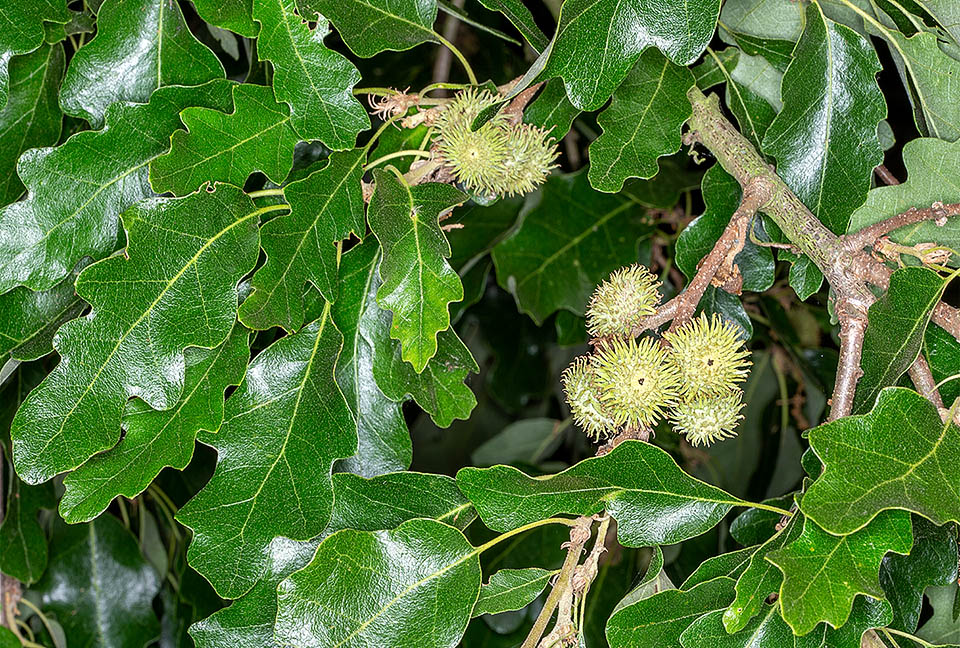
First year small acorns on a specimen of Quercus cerris ‘Longifolia Nova’. Between pollination and meiosis of the egg cell more than one year will pass © Giuseppe Mazza
As for many other species with high polymorphism, also for Quercus cerris have been created numerous binomina presently partly conserved as synonyms. «The Plant List, World Flora Online» mentions 27 of them whilst «The Euro+Med PlantBase» cites 45.
It is to be kept in mind that some of these taxa have been later on transferred to Quercus crenata. Besides the binomina relevant to the four varieties now mentioned have been employed as synonyms; among others we can remind Quercus asplenifolia, Quercus austriaca, Quercus crispa, Quercus crinita, Quercus frondosa and Quercus thracica.
Few years ago, in the Salento, was found a polycormic little tree with leaves intermediate between those of the Austrian oak (lobate) and those of the kermes oak (Quercus coccifera L.); this specimen has been named Quercus × caroppoi Medagli, Turco, Albano and Accogli but has not yet been validated since, at the moment, only this specimen is known.
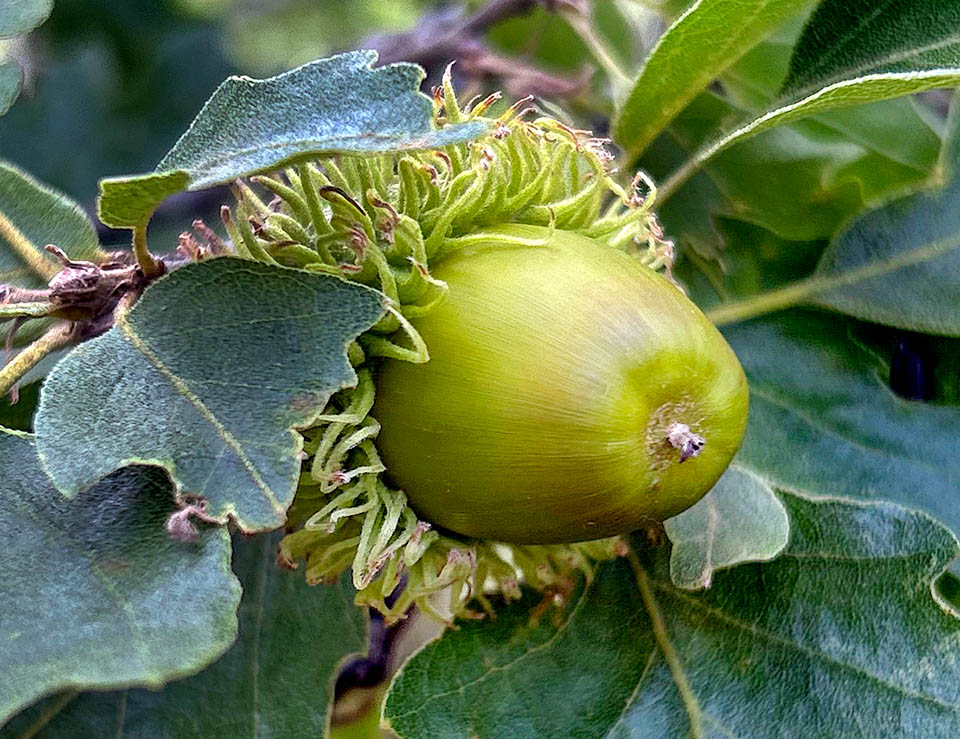
Developing second year acorn. The short mucro at the apex of the fruit is formed by the remains of the styles © Gabriele Prestifilippo
Few decades ago has been proposed the binomen Quercus gussonei (Borzì) Brullo for the populations of ‘Austrian oak’ of the supra Mediterranean band of the Nebrodi Mountains and of the Wood of the Ficuzza (Sicily). It would be a species, that in his time Giovanni Gussone (1787-1866) had reported as a variety, that distinguishes from the Austrian oak because it is more thermophilic and for the bigger leaves and acorns.
Several are the hybrids, recognized or proposed, between the Austrian oak and other oaks: Quercus × crenata Lam. (with Quercus suber; its synonyms, still in use, are Quercus × hispanica Lam., Quercus × pseudosuber Santi and Quercus × fontanesii Guss.), Quercus × libanerris Boom (with Quercus libani Oliv.), Quercus × schneideri Viehr. (with Quercus trojana), Quercus × baenitzii A.Camus (with Quercus pubescens), Quercus × kewensis Osborn (with Quercus wislizenii A.DC., a Californian oak of the subgen. Quercus, sect. Lobatae).
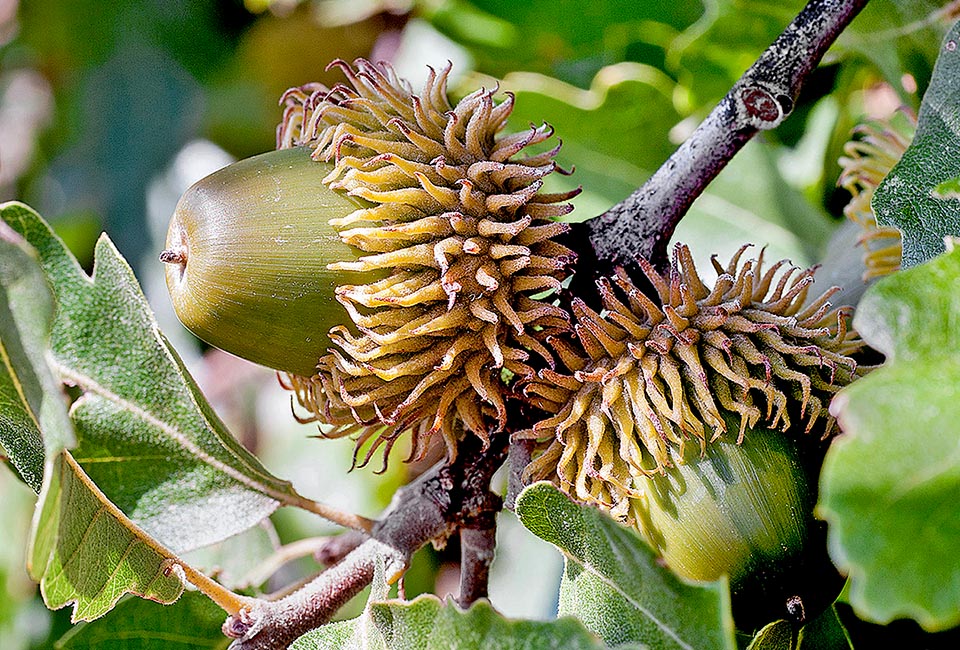
Ripe acorns. The dome has the characteristic subulate and pubescent scales, up to a ten millimetres long and above all free and never approached © Ignacio Pomar Gomá
For Anatolia are reported also possible hybrid forms with other oaks such as Quercus brantii Lindl., Quercus infectoria and Quercus ithaburensis, that however have not been attested.
Among these hybrids, the most known, diffused and also most utilized is without any doubt Quercus × crenata, natural hybrid between Austrian oak and cork oak, present, though not frequent, from SE France to NW Croatia, for which several botanists have proposed the rank of species Quercus × crenata, with the common name of ‘cerrosughera’ (Italian), ‘chêne crevelé’ (French), ‘Spanish oak’ (English), ‘falsche Kork-Eiche (German). It is a tree that at the regrowth completely replaces its foliage and that may reach 20 (30) m of height with a quite beautiful and proportionate posture and, for this reason, is employed as an ornamental, mainly isolated, plant.
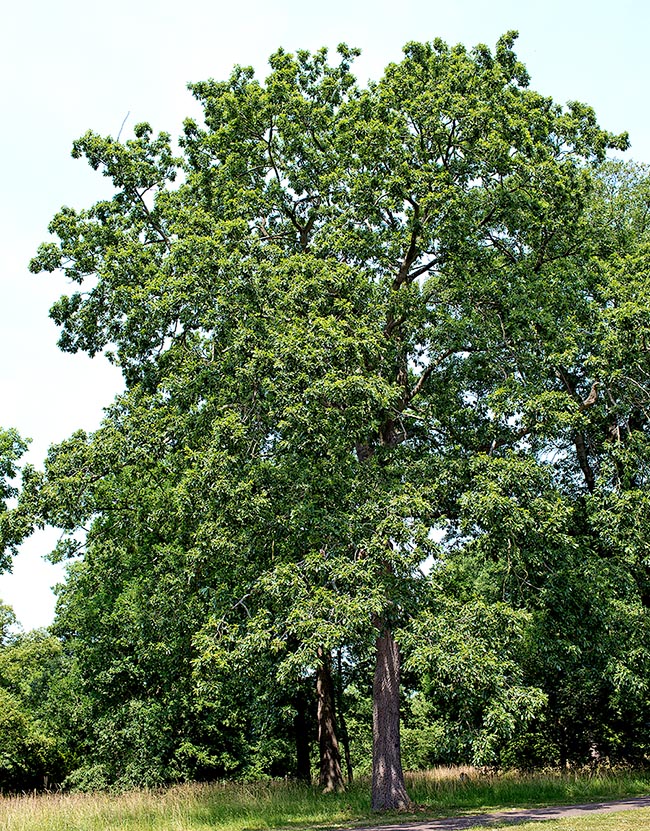
Majestic posture of a Quercus cerris ‘Longifolia Nova’ specimen © Giuseppe Mazza
The anthropic hybrids between Austrian oak and cork oak are usually inserted in the taxon Quercus × hispanica Lam. to highlight their origin, recent and above all artificial; they do not form a single clone since that several are the specimens hybridized spontaneously as well as those obtained by man.
The downy oak, as well as with sessile oak and with pedunculate oak, at first sight may be mistaken with the Austrian oak especially when the two species share the same environment. The main differences between the two species are:
– bark of the trunk in Quercus pubescens is brownish grey and smooth until the 5-7 years of age when it begins to crack into longitudinal and transversal grooves that delimit rather hard scales, with trapezoidal profile, long and taller than wide. In Quercus cerris it is dark grey and smooth and begins to crack by the 10-15 years of age in long and narrow longitudinale plates separated by thin grooves of colour going from intense red-orange to violet.
– branch of the year: in Quercus pubescens is cylindrical and covered by white to grey thick pubescence. In Quercus cerris it is angular and covered by a brown-reddish pubescence.
– buds: in Quercus pubescens, up to 9-12(15) mm long, are grey and pubescent especially along the edges of the perulae, the stipulae are not persistent. In Quercus cerris they are smaller, with reddish pubescence and with persistent stipulae, in turn pubescent, lesiniform, thin and twisted, up to 20-25 mm long.
– leaves: in Quercus pubescens they are from ovate-elongated to very wide in the central part and briefly cuneate or cordate at the base; they are (3) 5-10 cm long, with 5-6 entire lobes or also sublobate, more or less obtuse at the extremity; they are thickly pubescent when young, grey and smooth to the touch. In Quercus cerris they are oblanceolate to ovate or, more frequently, obovate; they are (5) 6-11 cm long and (2) 4 to 6 cm broad with lamina, dark green and rough to the touch above and lighter underneath, more or less deeply incise-lobate by 4-7 (9) couples of unequal lateral lobes often triangular and also mucronate at the apex; the base of the lamina may be truncated, rounded, or, also, subcordate; not infrequent are leaves not lobate but toothed along the edge.
– acorns: in Quercus pubescens they ripen annually; they have a dome covered by greyish small scalers quite pubescent, triangular, approached also at the apex and exceeding the edge of the cupola itself.
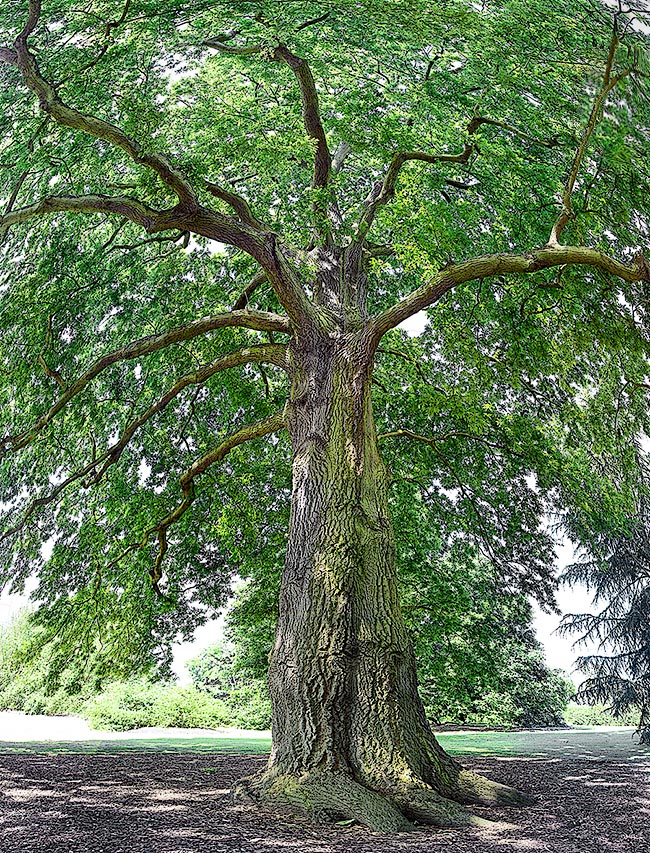
Dramatic ramification of a Quercus cerris ‘Laciniata’ that has grown freely in a park without any constraints © Giuseppe Mazza
In Quercus cerris they ripen every two years; the dome is very particular because it is covered by subulate scales, up to 10 mm long, brown-dark, free and never approached, that, in the whole, resemble a hairy head.
Among the oaks endemic to Middle East considered more or less similar to the Austrian oak stand, from west to east, Quercus trojana, present in south-eastern Italy, in eastern Mediterranean and in some zones of western Anatolia, Quercus ithaburensis, from the Salento peninsula to the south-eastern Balkan one and from Anatolia up to Sinai, Quercus look Kotschy, in Syria, Lebanon and in the north of Israel, Quercus libani and Quercus brantii Lindl., from easternTurkey to south-western Iran and Quercus castaneifolia C.A. Mey., from the Caucasian region up to northern Iran.
If we consider them as species, we must also keep in mind Quercus crenata and Quercus gussonei.
The latter is an endemism of northern Sicily; it differs from the Austrian oak because it’s more thermophilic and because it has more ample leaves with less deeply incised edge, and bigger acorns.
However, its systematic position is still subject to research and discussion in order to be able to define if the taxon is to be evaluated as a species (Quercus gussonei (Borzì) Brullo) or as a variety (Quercus cerris var. gussonei Borzì).
The possible legitimacy of the binomen Quercus gussonei validates also the recognition of Quercus × fontanesii Guss. as a natural Sicilian hybrid between Quercus gussonei and Quercus suber.
→ To appreciate the biodiversity within the FAGACEAE family please click here.
